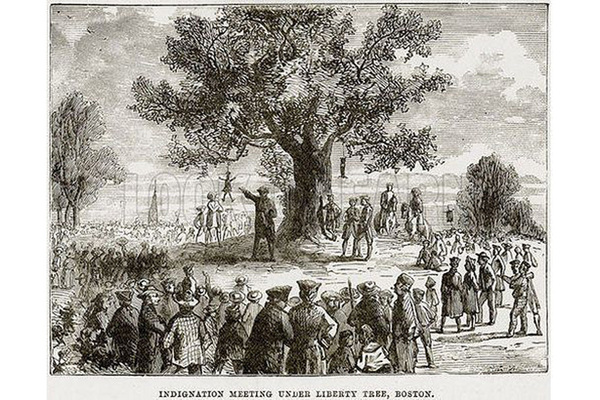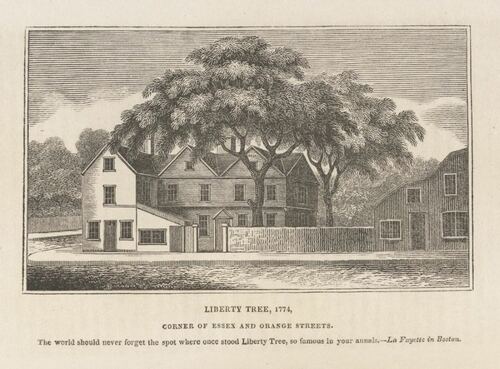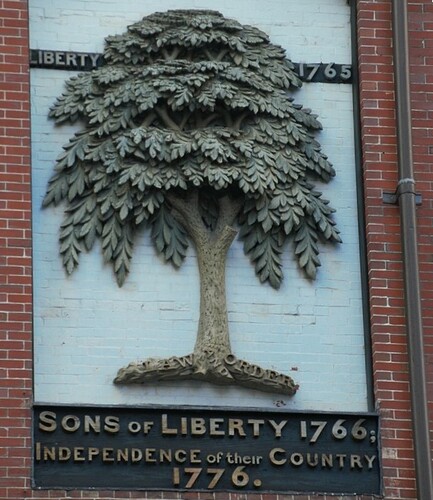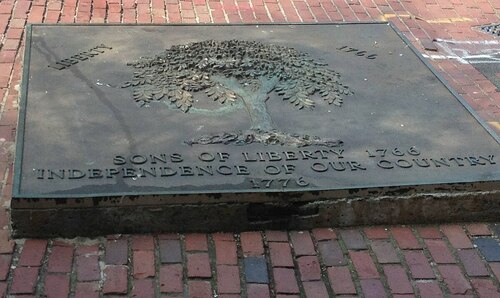The Liberty Tree: A Forgotten Symbol of the American Revolution

Rediscovering a Revolutionary Icon
Summer is here, and as everyone gathers to celebrate America’s 241st birthday, Arborist Now is taking this time to publish a short article about The Liberty Tree and the role it played as the colonists resisted the rule of King George III. We hope you enjoy this glimpse into our great American history.
The Historical Significance of the Liberty Tree

An 1825 Illustration of the Liberty Tree (Wikimedia Commons)
The Liberty Tree, an elm tree in Boston, became a powerful symbol of resistance against British rule in the American colonies. Its legacy began on August 14, 1765, when a group of patriots, later known as the Sons of Liberty, gathered under its branches to protest the Stamp Act. They hung an effigy of Andrew Oliver, the appointed Stamp Act distributor, as a powerful act of defiance. This public demonstration marked the beginning of the American resistance that ultimately led to the Revolutionary War.
The Stamp Act and Colonial Unrest
In 1765, the British government imposed a Stamp Act on the American colonies. It required all legal documents, permits, commercial contracts, newspapers, pamphlets, and playing cards in the American colonies to carry a tax stamp. Because the act applied to papers, newspapers, advertisements, and other publications and legal documents, it was viewed by the colonists as a means of censorship, or a "knowledge tax," on the rights of the colonists to write and read freely.
The Liberty Tree as a Symbol of Defiance
In the years leading up to the war, the British made the Liberty Tree an object of ridicule. British soldiers tarred and feathered a man named Thomas Ditson and forced him to march in front of the tree. During the siege of Boston, a party of Loyalists led by Job Williams defiantly cut the tree down in an act of spite, knowing what it represented to the patriots, and used the tree for firewood. This act only further enraged the patriots. As resistance to the British grew, flags bearing a representation of the Liberty Tree were flown to symbolize the unwavering spirit of liberty. These flags were later a common sight during the battles of the American Revolution.
Commemorating the Liberty Tree

A Marker on a Brick Wall at the Site of the Liberty Tree (Wikimedia Commons)
For many years the remnant of the tree was used as a reference point by local citizens, similar to the Boston Stone, and became known as the "Liberty Stump." Later the citizens in many of the colonies erected a Liberty Pole in commemoration of the Liberty Tree.
Other towns designated their own Liberty Trees as well. The Liberty Tree in Acton, Massachusetts was an elm tree that lasted until about 1925. In 1915, knowing that the Liberty Tree was getting older, Acton students planted the Peace Tree, a Norway maple that still stands today.
The Legacy of the Liberty Tree in Modern Times
Liberty Trees that were designated in the original Thirteen Colonies were eventually lost over time as well. A 400-year-old tulip poplar stood on the grounds of St. John's College in Annapolis, Maryland until 1999, when it was felled after Hurricane Floyd caused irreparable damage to it. The wood from this tree was acquired and progressively used by Taylor Guitars to produce limited-edition musical instruments: 400 of their Grand Concert guitars; 400 of their Baby Taylor guitars; and 50 of their T5 guitars (each named for one of the fifty states, sequenced in the order in which that state joined the Union). Randolph, New Jersey claims a white oak Liberty Tree dating to 1720.
Thomas Jefferson and the Tree of Liberty

A Sidewalk Marker in Liberty Tree Plaza in Boston (Wikimedia Commons)
The phrase "Tree of Liberty" is also famously associated with Thomas Jefferson, who wrote, "The tree of liberty must be refreshed from time to time with the blood of patriots and tyrants." This powerful statement underscores the continuous struggle for freedom and the sacrifices required to maintain it. Jefferson's words have kept the spirit of the Liberty Tree alive, resonating through generations as a reminder of the ongoing fight for justice and liberty.
Arborist Now: Preserving Historical Trees
As we reflect on the significance of the Liberty Tree, it's important to remember the role of tree care professionals in preserving these living symbols of history. Arborist Now, a San Francisco-based tree care company, is dedicated to maintaining the health and vitality of trees, ensuring that symbols like the Liberty Tree can be enjoyed by future generations. Our team offers comprehensive tree care services, from pruning and maintenance to emergency care and preservation.
Conclusion
The Liberty Tree stands as a powerful symbol of American resistance and the enduring fight for freedom. From its roots in colonial protests to its lasting legacy in modern times, the Liberty Tree reminds us of the sacrifices made for liberty. Arborist Now is proud to honor this legacy by providing expert tree care services in the San Francisco Bay Area. Contact us today to learn more about how we can help preserve the health and beauty of your trees.
For more information on the Liberty Tree and our services, visit our blog or contact us directly!
Originally published on July 5, 2017.





